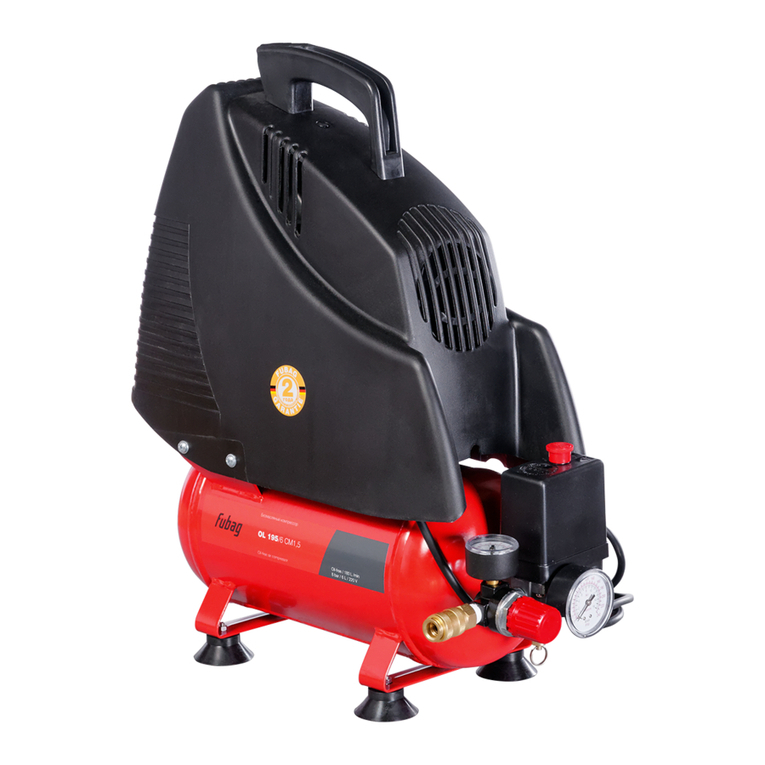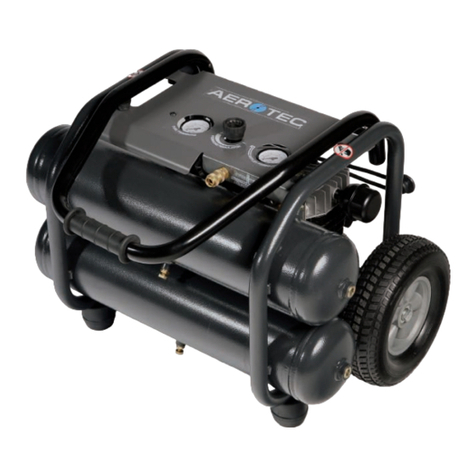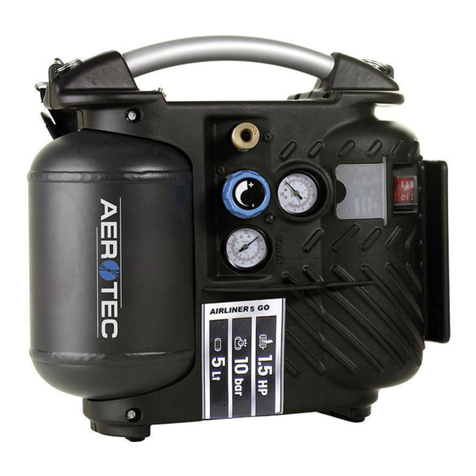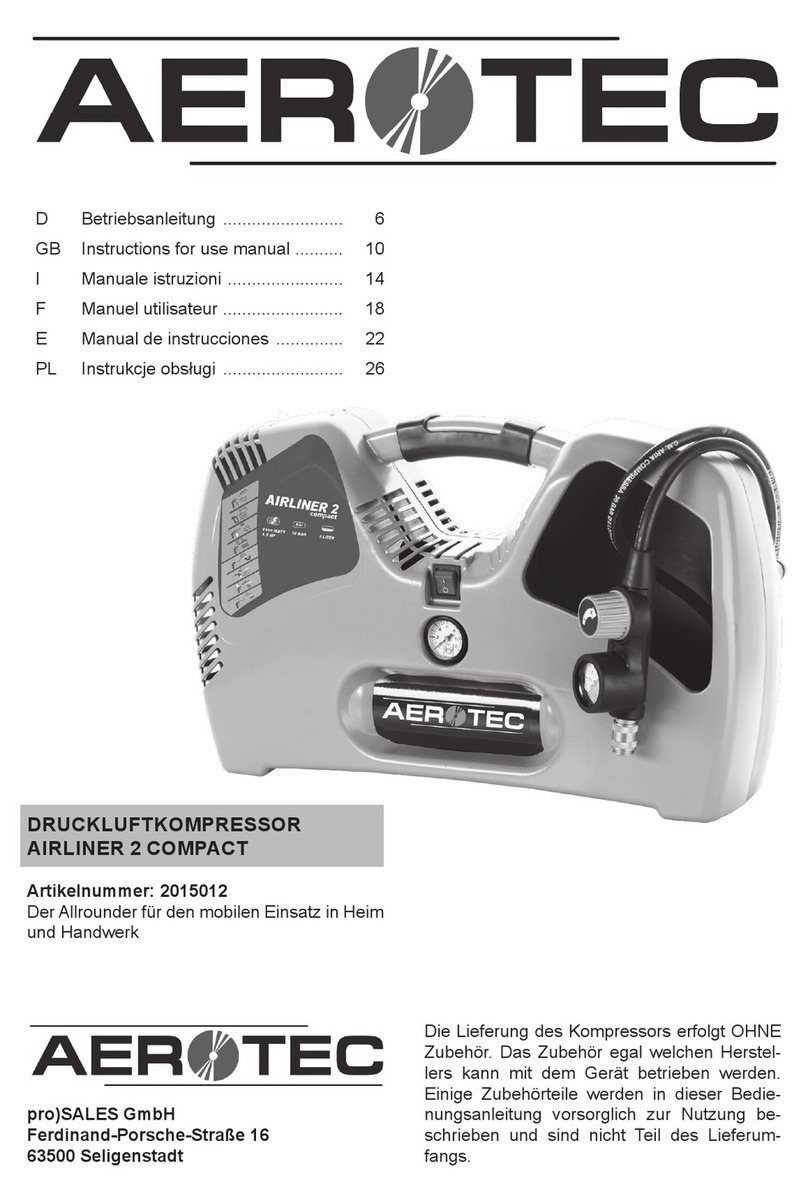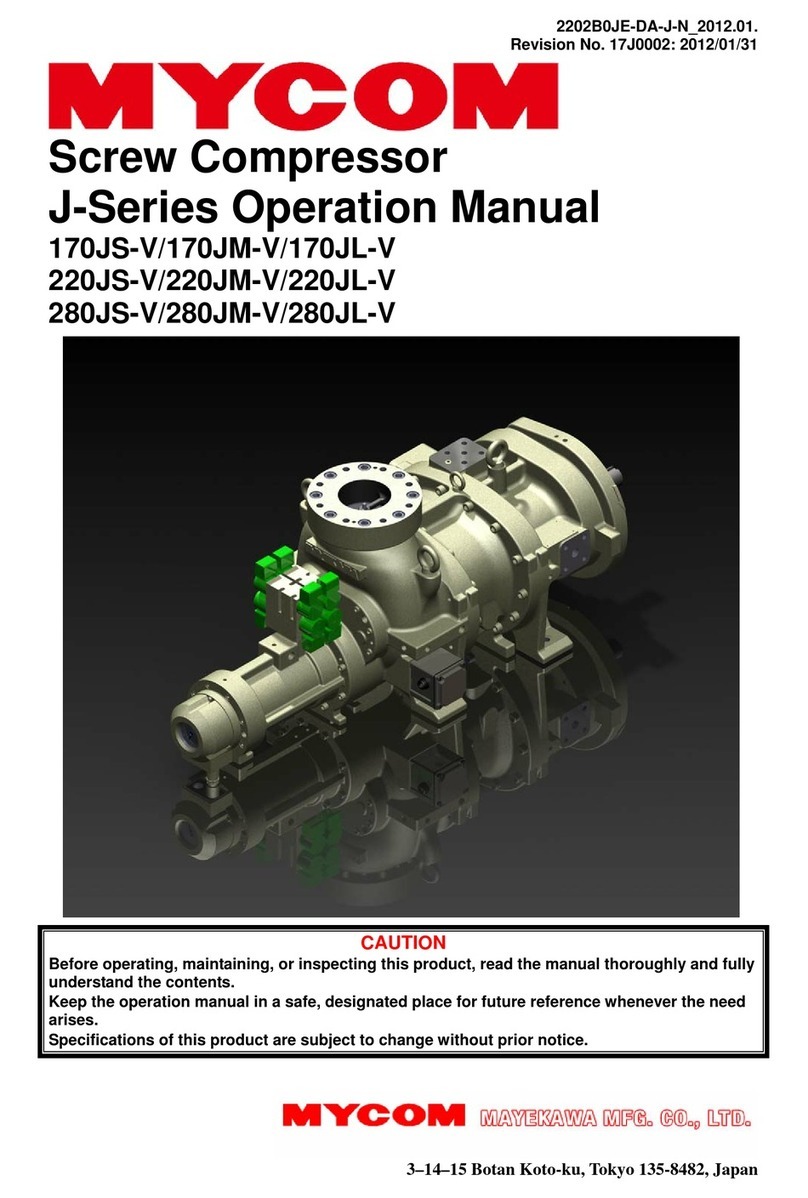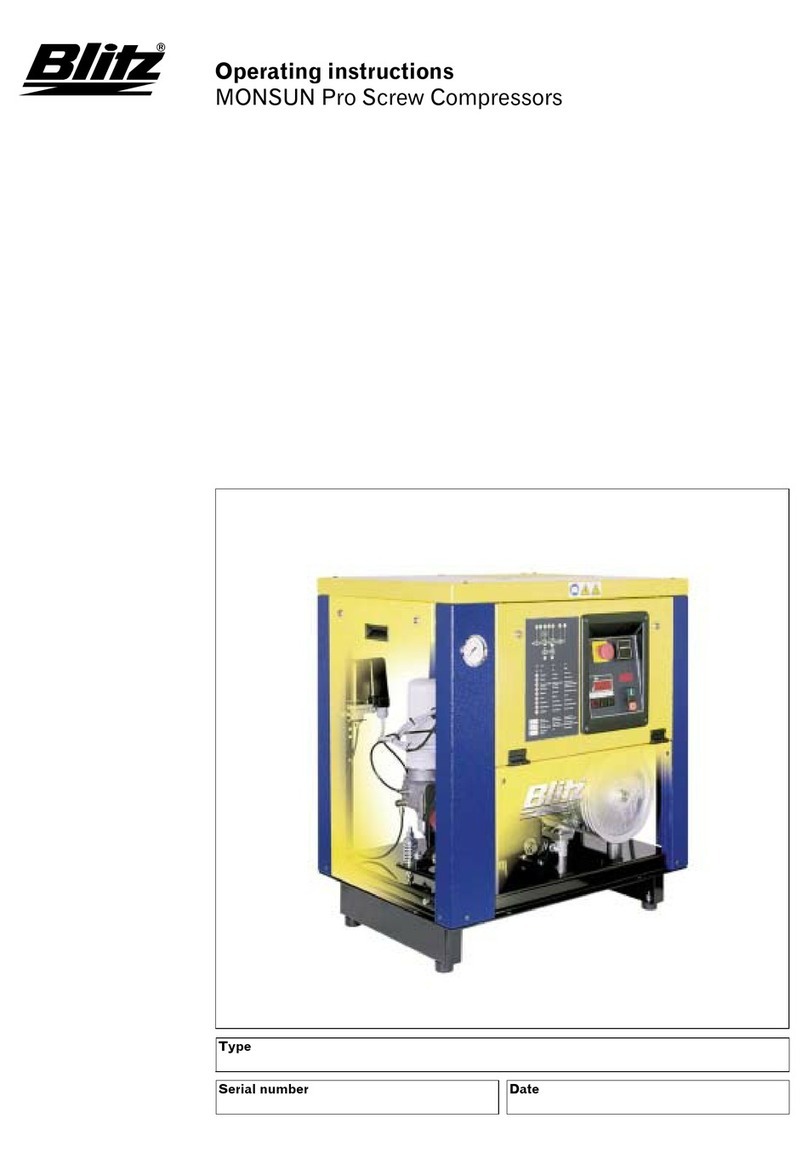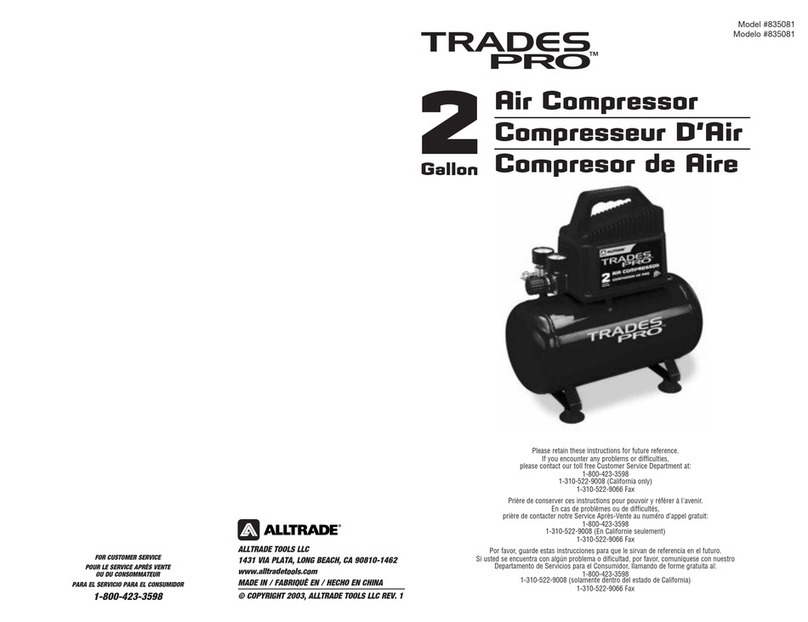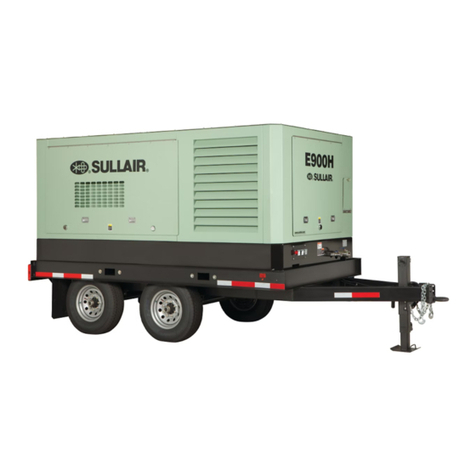Aerotec MKK-O-236 D User manual

ENGLISH - FRANÇAIS - ESPAÑOL - ITALIANO - NEDERLANDS - DEUTSCH -
SVENSKA - NORSK - DANSK - SUOMI - РУССКИЙ - POLSKI
Instruction manual
Mode d’emploi
Manual de instrucciones
Manuale istruzioni
Instructies gebruiksaanwijzing
Bedienungsanleitung
Instruktionshandbok
Bruksanvisning
Instruktionshåndbog
Käyttöopas
Руководство по эксплуатации
Instrukcja obsługi


ENGLISH
Instruction manual


3
1 - SAFETY PRECAUTIONS
1.1 Safety symbols
Explanation
Danger
Warning
Important note
1.2 General safety precautions
General precautions
1. The operator must adopt safe work procedures and comply with all the safety requisites and stan-
dards in the workplace.
2. Should any of the following provisions not conform to the regulations in force, the most stringent of
the two applies.
3. The activities relative to the installation, operation, maintenance and repairs must be carried out only
by suitably authorised, trained and specialised personnel.
4. The quality of the air generated by the compressor is not considered to be breathable. For the quality
of compressed air to be breathable, it must be suitably puried according to the applicable regula-
tions and standards.
5. Before carrying out any extraordinary maintenance, repair, adjustment or checking operations, stop
the compressor, press the emergency stop button, disconnect the mains and de-pressurise the com-
pressor. Furthermore, the isolating switch must be opened and properly locked.
6. Never play with compressed air. Do not aim it towards the skin nor aim air jets at persons.
Never use it to remove dirt from one’s own clothes. When compressed air is used to clean equipment,
handle it with extreme caution and wear protective goggles.
7. The owner is responsible for keeping the unit in safe operating conditions.All spares and accessories
that could in any way jeopardise safety must be replaced.

instruction manual
4
8. Do not walk or stand on the compressor or its components.
1.3 Safety precautions during installation
The manufacturer declines any responsibility whatsoever for damages or injuries
that may derive through failure in observing these precautions or normal caution
and through failing to provide the required attention for the installation, operation,
maintenance and repairs, even if not expressly quoted
Precautions during installation
1. The machine must be lifted by exclusively using suitable equipment, conforming to the applicable
safety regulations. Loose or rotating components must be safely secured before hoisting operations
are carried out. It is strictly forbidden to stop or stand in the risk area below suspended loads. Hoisting
acceleration or deceleration must be maintained within safety limits. A safety helmet must be worn
when working in an area with overhead or hoisting equipment.
2. Place the machine in an area where the ambient air is as fresh and clean as possible. If necessary,
install a suction conduit. Do not obstruct air vents. Utmost attention must be paid to reducing to the
minimum the possibility of humidity being introduced together with the intake of air.
3. Before connecting any pipes, all blind anges, plugs, covers and hygroscopic substance sachets
must be removed.
4. Air exible hoses must be of the correct dimensions and must be suitable for the operating pressure
exercised. Never utilise worn, damaged or perished exible hoses. Dimensions of the distribution
pipes and connections must be correct and suitable for the operating pressure.
5. Intake air must be free of smoke, vapours and ammable particles, such as those from paint solvent,
which could cause a re to ignite or an internal explosion.
6. Set up the intake air vent so that there is no risk of wide garments being sucked in.
7. Ensure that the exhaust pipe connecting the compressor to the end refrigerator or the compressed
air network can expand with the heat and that it will not be in contact with or in proximity of ammable
material.
8. No external force must be exercised on the air outlet valve: The connected pipe must not be subjected
to stresses.
9. If a remote control is installed, the machine must have a clearly visible notice indicating: DANGER:
10. The machines must be installed in a way that ensures that there is a suitable cooling air ow availa-

5
instruction manual
5
ble, and that the exhaust air will not re-circulate towards the compressor air intake or the cooling air
inow vent.
11. The electrical connections must conform to the applicable standards. The machines must be tted
with a ground connection and protection fuses against short circuits on all phases. Near the compres-
sor, a lockable circuit breaker must be installed.
12. On machines with an automatic start-stop system, or if the function for automatic re-starting after
power interruptions is activated, a notice must be afxed next to the instrument panel, stating the
following “This machine can start suddenly without notice”.
13. In systems with multiple compressors, manual valves must be installed that will isolate each com-
pressor. Never rely on non-return valves for insulating pressurised systems.
14. Do not remove or tamper with safety devices, protections or isolators tted to the machine. Each
pressurised or auxiliary tank installed outside the machine to contain air whose pressure exceeds at-
mospheric pressure, must be protected by a pressure-discharging device or by compulsory devices.
15. Piping and other parts that can reach a temperature exceeding 80 °C (176 °F) and that could acciden-
tally be touched by personnel during normal operations, must have protection or be isolated. Other
high temperature pipes must be clearly marked accordingly.
16. Should the ground not be at or should it be subject to variable inclinations, consult the manufacturer.
Furthermore, read the following safety precautions: Safety precautions during ope-
ration and during maintenance works.
These precautions apply to machinery that use or consume air or inert gasses.
The use of any other gas requires further safety precautions typical of this specic
application and are not included in this publication.
Several precautions are only of a general nature and refer to various types of
equipment and machines; it follows that some instructions may not apply to your
machine.
1.4 Safety precautions during operation
The manufacturer declines any responsibility whatsoever for damages or injuries
that may derive through failing to observe these precautions or normal caution and
through failure in providing the required attention for the installation, operation,
maintenance and repairs, even if not expressly quoted.

instruction manual
6
Precautions during operation
1. Only use couplings and connections for exible hoses of correct types and dimensions. While the
air ows through the exible hose or air pipe, ensure that the open extremity is being held rmly. A
loose extremity can forcibly strike and cause injuries. Ensure that a exible hose is completely de-
pressurised before disconnecting it.
2. Operators starting machines in remote control mode must take opportune precautions to be certain
that no one is checking or working on the machine. For this purpose, a suitable notice must be afxed
on equipment that can be started in remote mode.
3. Never get the machine to operate when there is the risk that fumes, vapours or ammable or toxic
particles could be sucked in.
4. Never get the machine to operate below or above its capacity limits.
5. Workers operating in environments or places in which the noise level pressure reaches or exceeds
90 dB(A) must wear protective hearing devices.
6. Periodically check that:
• All protections are in place and securely fastened
• All exible hoses and/or pipes inside the machine are in good condition, rmly positioned and are not
subject to friction.
• That there are no leaks.
• All fastening elements are properly tightened.
• All current conductors are rm and in optimal condition.
• Safety valves and other pressure attenuation devices are not obstructed by dirt or paint.
• The air outow valve and the air circuit (for example, conduits, couplings, manifolds, valves, exible
hoses, etc.) are in good condition, not worn or being inappropriately used.
7. In air heating systems, should hot air from compressors used for refrigerating be used, for example
to heat a work environment, adopt suitable precautions against pollution and the possible contamina-
tion of air to be breathed.
8. Do not remove, or tamper with, any element of the sound-proong material.
9. Do not remove or tamper with safety devices, protections or isolators tted to the machine. Each
pressurised or auxiliary tank installed outside the machine to contain pressurised air that exceeds at-
mospheric pressure, must be protected by a pressure-discharging device or by compulsory devices.

7
instruction manual
7
Furthermore, read the following safety precautions: Safety precautions during instal-
lation and Safety precautions during maintenance .
These precautions apply to machinery that use or consume air or inert gasses. The
use of any other gas requires further safety precautions typical of this specic ap-
plication and are not included in this publication. Several precautions are only of a
general nature and refer to various types of equipment and machines; it follows that
some instructions may
not apply to your machine.
1.5 Safety precautions during maintenance or repair
Il produttore declina qualsiasi responsabilità per danni o lesioni derivanti dall’inos-
servanza di queste precauzioni o della normale cautela e dalla mancata attenzio-
ne richieste per l’installazione, il funzionamento, la manutenzione e la riparazione,
anche se non espressamente citata.
Precautions during maintenance or repairs
1. Always wear protective goggles.
2. When carrying out maintenance and repair work exclusively use appropriate tools.
3. Only use original spare parts.
4. Any maintenance work must only be carried out once the machine has cooled off.
5. A warning notice such as “Work in progress; do not start” must be afxed on the starting equipment.
6. Operators starting machines in remote control mode must take opportune precautions to be certain
that no one is checking or working on the machine. For this purpose, a suitable notice must be afxed
on the equipment that can be started in remote mode.
7. Before removing any pressurised component, ensure that the machine is properly isolated from all
sources of pressure, and discharge pressure from the whole system.
8. Never use ammable solvents or carbon tetrachloride to clean the components. Implement precau-
tionary safety measures against toxic emissions from cleaning uids.
9. Keep the work place scrupulously clean during maintenance and repair works. Protect against dirt by
covering exposed parts and openings with a clean cloth, paper or adhesive tape
10. Do not carry out welding or other operations that could emanate heat close to the lubrication system.
Oil canisters must be thoroughly cleaned, for example by steam, before performing these operations.

instruction manual
8
Never weld or modify pressure tanks in any way.
11. Should evident signs or suspicions of overheating be found on an internal part of the machine, stop
the machine, but do not open any inspection cover until sufcient time has lapsed for cooling; in this
way the risk of spontaneous combustion of oil vapours upon the inow of air is avoided.
12. Never use a source of light with naked ame to inspect the inside of the machine, the pressurised
tank, etc.
13. Ascertain that no tools, loose parts or rags were left in the machine, or its interior.
14. Maintenance of all adjustment and safety devices must be carried out with due diligence to guarantee
correct operation. They must never be deactivated.
15. Before clearing the machine for use, after maintenance or overhauls, check that the settings relative
to pressures, temperatures and operating timings are correct. Check that all control and stopping
devices are activated and that they operate correctly. If removed, check that the protection of the
compressor drive shaft’s coupling has been reinstalled.
16. Protect the engine, air lter, electrical and adjustment components, etc., to avoid humidity being in-
troduced, for example when cleaning by steam is required.
17. Make sure that all sound-proong material and anti-vibration buffers, for example the sound-proong
material present on the body and in the compressor air inow and outow systems, are in good con-
dition. If damaged, replace with the original material from the manufacturer, to avoid increasing the
sound pressure level.
18. Never use corrosive solvents that could damage the compressed air network, for example poly-
carbon trays.
19. When handling refrigerating substances, the following safety precautions are highlighted:
Never inhale refrigerating vapours. Check that the work area is suitably ventilated; if necessary, adopt
personal protective breathing devices.
Always wear special gloves. In case of skin coming into contact with refrigerant, rinse thoroughly with
water. Should the refrigerating uid come into contact with the skin through the clothing, do not rip
or remove them; pour abundant fresh water on the fabric until there are no more traces of refrigerant
visible; then go to the rst aid room.
20. Hands should be protected to avoid being injured on the scalding parts of the machine, for example
while oil is being drained.

9
instruction manual
9
Furthermore, read the following safety precautions: Safety precautions during in-
stallation and Safety precautions during operation.
These precautions apply to machinery that use or consume air or inert gasses.
The use of any other gas requires further safety precautions typical of this specic
application and are not included in this publication.
Several precautions are only of a general nature and refer to various types of
equipment and machines; it follows that some instructions may not apply to your
machine.

10
2 - GENERAL DESCRIPTION
2.1 Introduction
General
Compressors are air cooled, by two cylinders, single-stage and bi-stage, with oil-less and lubricated pi-
ston. Pumping units are manufactured for effective operating pressures of up to 20 bar, and compressors
for effective pressures of up to 15 bar.
UNITS
3
2
1
4
5
6
5
7
8
1
3
7
8
6
2
9
4

11
instruction manual
11
BASE-MOUNTED
51
63
7
8
4
1
2
3
4
5
9
1012
13
11

instruction manual
12
BASE-MOUNTED, SILENCED
TANK-MOUNTED
12
10
13
14
1
3
12
10
4
2
16
15
17
5
11
11

13
instruction manual
13
TANK-MOUNTED, SILENCED
TANK-MOUNTED, SILENCED WITH DRYER
14
15 16
17
12
10
15
16
12
17
14
18
11
11

instruction manual
14
TANK-MOUNTED, VERTICAL
TANK-MOUNTED, VERTICAL WITH DRYER
16
1
5
4
7
8
6
3
12
10
15
1
16
3
15
2
8
7
4
5
18
17
17
6
11

15
instruction manual
15
WHEEL-MOUNTED
Riferimento Descrizione
1 Cylinder 1
2 Cylinder 2
3 Motor
4 Pumping unit
5Air lter
6Oil ller plug
7 Oil level viewer
8 Oil drain plug
9 Safety valve
10 Gauge
11 Pressure switch circuit breaker
12 Pressure switch
13 Buffer tank
14 Sound-proofed panels
15 Condensate discharge
16 Air tank
17 Air delivery
18 Dryer
19 Pressure reducer
20 Handle
20 12
19
15
4
5
12
3
16
6
17
10
11

instruction manual
16
Versions
The compressor unit includes:
• Base
• Cylinders
• Air lter
• Fan
• Pressure switch
• Safety valve (on some models)
• Flanged electrical motor
The units assembled on the base include:
• Compressor unit
• Air lter
• Pressure switch
• Fan
• Safety valve
• Gauge
• Flanged electrical motor
• Buffer tank
• Sound-proong panelling (on some models)
The unit mounted on the base is completely operative and equipped with pressure switch and buffer tank
The units assembled on the tank include:
• Compressor unit
• Air lter
• Pressure switch
• Fan
• Safety valve
• Gauge
• Flanged electrical motor
• Sound-proong panelling (on some models)

17
instruction manual
17
• Tank, both horizontal and vertical
The Full Feature units (assembled on the tank with dryer) include:
• Compressor unit
• Air lter
• Pressure switch
• Fan
• Safety valve
• Gauge
• Flanged electrical motor
• Sound-proong panelling
• Tank, both horizontal and vertical
• Dryer with automatic condensate discharge
The Full Feature compressor is a compressor mounted on a tank equipped with a refrigerating gas dryer,
with lter DD and PD. These dryers remove the humidity from the compressed air, cooling it down to a
temperature close to freezing point. This causes condensate to form. The condensate gets automatically
discharged. The air gets heated before owing out of the dryer.
2.2 Options
The compressors can be integrated with the following options. For detailed information please refer to
the Assistance Centre.

instruction manual
18
Reference Description
Electronic condensate discharge
Control unit for star-triangle starting
Galvanised tank.
AD2000 galvanised tank
2.3 Air ow
Flow diagram references
Riferimento Descrizione
AF Air lter
AR Tank
AV/ AV1/AV2 Air outlet valves
CV Non-return valve
DD Dryer lter
DP Oil drain plug
DM Condensate discharge valve
FC Oil ller plug
FN Fan
GP Gauge
MMotor
MDR Pressure switch
PD Dryer lter
S1 On/Off switch
SG Oil level viewer
SV Safety valve
US Discharge silencer
Y1 Solenoid valve
This manual suits for next models
31
Other Aerotec Air Compressor manuals
Popular Air Compressor manuals by other brands

Harbor Freight Tools
Harbor Freight Tools Central Pneumatic 40400 Assembly and operating instructions
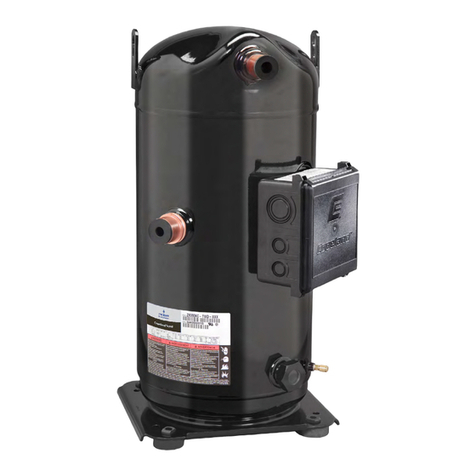
Emerson
Emerson Copeland Scroll ZR KC Series Bulletin
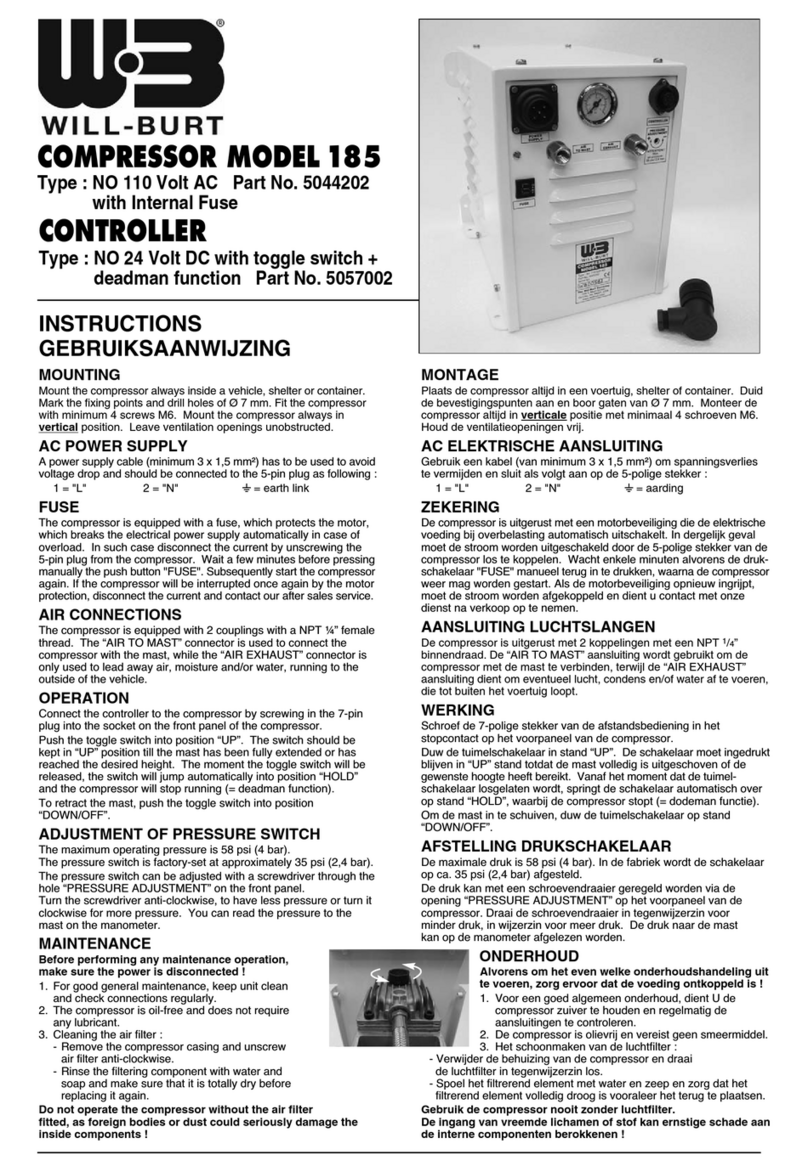
Will Burt
Will Burt 185 instructions
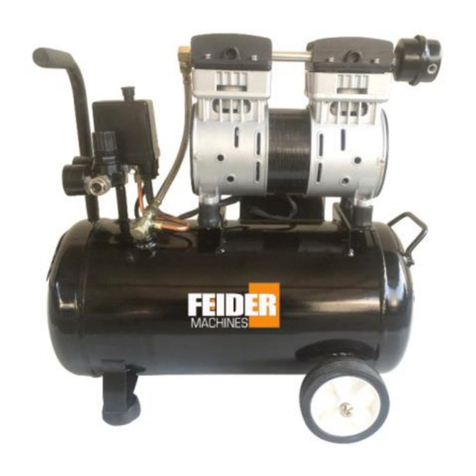
Feider Machines
Feider Machines FC6LS instruction manual
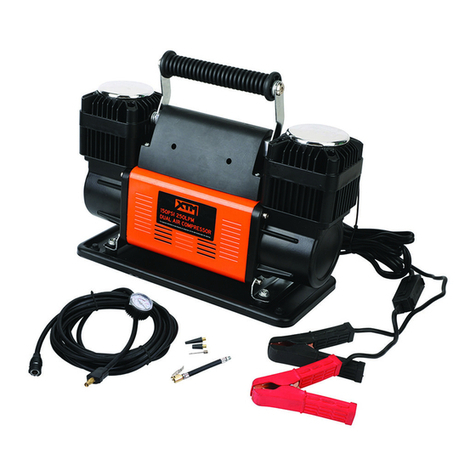
XTM
XTM 645860 owner's manual
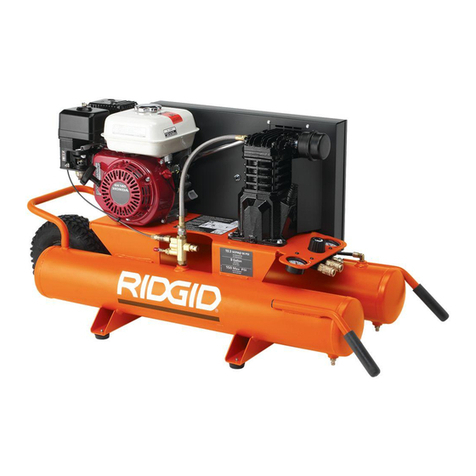
RIDGID
RIDGID GP90150A Operator's manual

Bushranger
Bushranger Max Air III 55x23 owner's manual

Fieldmann
Fieldmann FDAK 70205-0 user manual

Atlas Copco
Atlas Copco XA146 Dd instruction manual
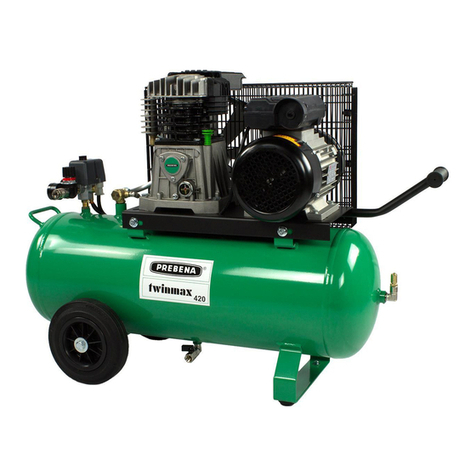
Prebena
Prebena TWINMAX 420 Original instructions
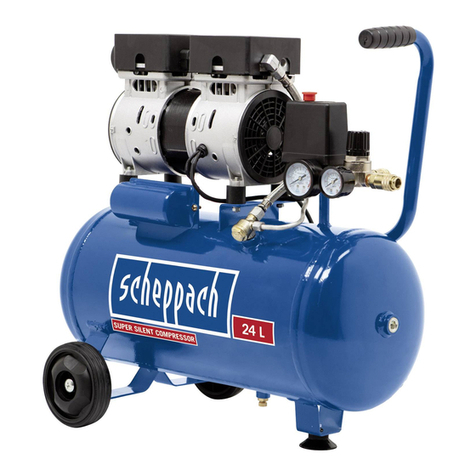
Scheppach
Scheppach HC24Si Translation from the original instruction manual
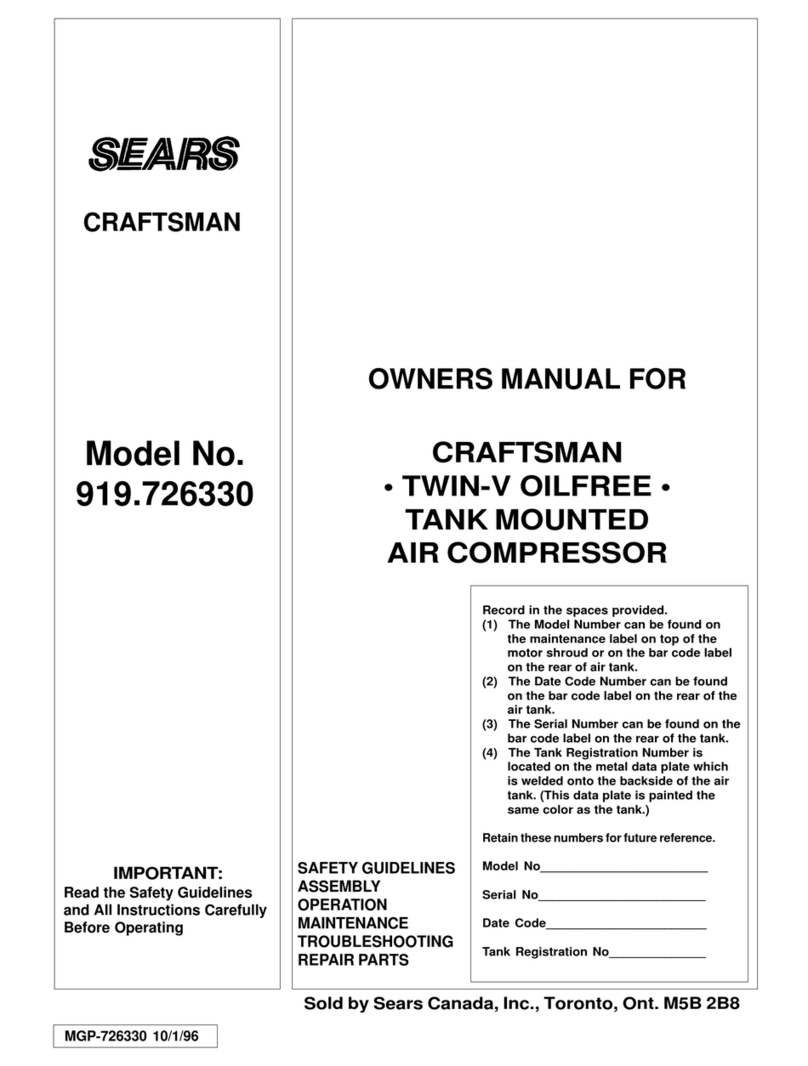
Sears
Sears 919.72633 owner's manual
